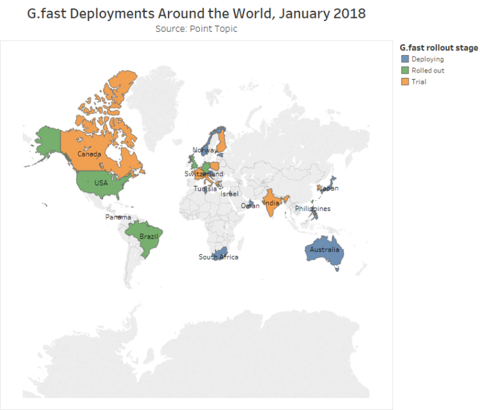Gfast, an emerging broadband technology that allows service providers to advance fiber-like speeds over existing copper and coax over short distances, is being aggressively trialed and rolled out by a growing list of service providers in the United States and internationally.
As of early 2018, Point Topic said in a recent report that about 3 million premises have been passed with Gfast networks.
The research firm said that an estimated 29,000 households subscribe to Gfast services, the majority of which are in Southeast Asia.
RELATED: AT&T begins marketing Gfast services in 22 U.S. metro markets
Led by aggressive Tier 1 telcos, including AT&T, CenturyLink and BT, Point Topic’s research found that 33 service providers in all have either deployed or plan to roll out Gfast at some point in the future. Out of this group, 14 providers are conducting lab and field trials while another 13 are deploying Gfast in their networks, with commercial launches expected in the next 1 to 2 years.

“It’s a rapidly evolving market,” said Dr. Jolanta Stanke, research director at Point Topic, in a release. “Now that the early implementations and some significant testing and pilot schemes are winding up we’ll start to see real acceleration in network footprints and adoption.”
Six service providers worldwide currently offer Gfast services, with maximum download speeds offered varying from 300 Mbps to 500 Mbps.
However, there are some realities about Gfast. While the technology could have utility in longer-range networks, many U.S.-based providers are targeting it for use in multi-dwelling unit (MDU) configurations like apartment complexes and condominium developments.
In the United States, AT&T is clearly leading the Gfast charge, targeting 22 metro networks this year. After conducting a Gfast trial in Minneapolis, AT&T named eight cities in which properties will be equipped with the hybrid fiber/copper and coax technology.
A number of these cities, including Boston and New York, are outside of AT&T’s traditional 21-state wireline internet serving area. AT&T is also selling Gfast to MDUs in parts of 14 other metros, with more deployments planned. In Boston the rollout makes the telco a new competitor to incumbents Verizon and Comcast.
No less compelling are CenturyLink and Frontier.
CenturyLink launched a pilot in 800 apartments in Platteville, Wisconsin, while Frontier told FierceTelecom that it will use Gfast to bring higher-speed broadband services to apartment buildings that have not been equipped with fiber within its growing Fios footprint.
Frontier began its Gfast journey in Connecticut, aiming the technology at increasing in-building broadband speeds for customers that live in MDUs. Following a Gfast test bed it has been conducting in one building in Connecticut, Frontier plans to extend Gfast to more locations throughout 2018.
Outside of the U.S., BT and Swisscom are leading Gfast deployments in Europe. In the U.K., BT has committed to covering 10 million premises by 2020, although only 93,000 are live as of early 2018. The operator uses FTTC (fiber to the cabinet) to offer up to 330 Mbps.
